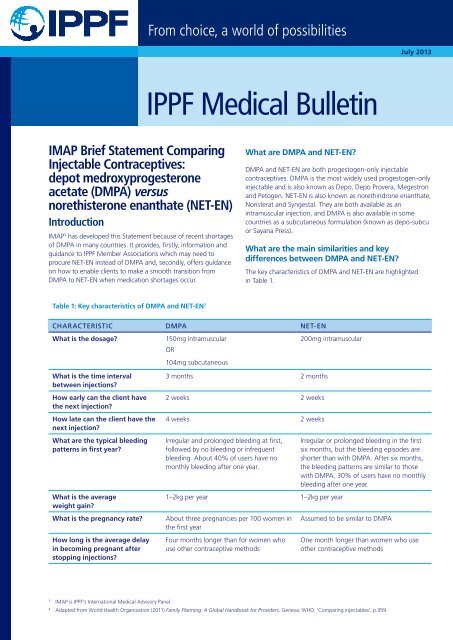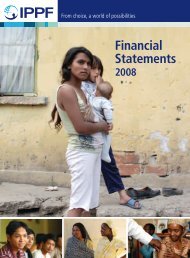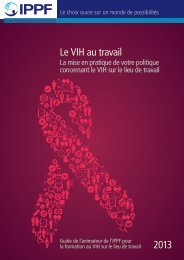IPPF Medical Bulletin
IPPF Medical Bulletin
IPPF Medical Bulletin
You also want an ePaper? Increase the reach of your titles
YUMPU automatically turns print PDFs into web optimized ePapers that Google loves.
From choice, a world of possibilities<br />
July 2013<br />
<strong>IPPF</strong> <strong>Medical</strong> <strong>Bulletin</strong><br />
IMAP Brief Statement Comparing<br />
Injectable Contraceptives:<br />
depot medroxyprogesterone<br />
acetate (DMPA) versus<br />
norethisterone enanthate (NET-EN)<br />
Introduction<br />
IMAP 1 has developed this Statement because of recent shortages<br />
of DMPA in many countries. It provides, firstly, information and<br />
guidance to <strong>IPPF</strong> Member Associations which may need to<br />
procure NET-EN instead of DMPA and, secondly, offers guidance<br />
on how to enable clients to make a smooth transition from<br />
DMPA to NET-EN when medication shortages occur.<br />
What are DMPA and NET-EN?<br />
DMPA and NET-EN are both progestogen-only injectable<br />
contraceptives. DMPA is the most widely used progestogen-only<br />
injectable and is also known as Depo, Depo Provera, Megestron<br />
and Petogen. NET-EN is also known as norethindrone enanthate,<br />
Noristerat and Syngestal. They are both available as an<br />
intramuscular injection, and DMPA is also available in some<br />
countries as a subcutaneous formulation (known as depo-subcu<br />
or Sayana Press).<br />
What are the main similarities and key<br />
differences between DMPA and NET-EN?<br />
The key characteristics of DMPA and NET-EN are highlighted<br />
in Table 1.<br />
Table 1: Key characteristics of DMPA and NET-EN 2<br />
CHARACTERISTIC DMPA NET-EN<br />
What is the dosage?<br />
150mg intramuscular<br />
OR<br />
104mg subcutaneous<br />
200mg intramuscular<br />
What is the time interval<br />
between injections?<br />
How early can the client have<br />
the next injection?<br />
How late can the client have the<br />
next injection?<br />
3 months 2 months<br />
2 weeks 2 weeks<br />
4 weeks 2 weeks<br />
What are the typical bleeding<br />
patterns in first year?<br />
What is the average<br />
weight gain?<br />
What is the pregnancy rate?<br />
How long is the average delay<br />
in becoming pregnant after<br />
stopping injections?<br />
Irregular and prolonged bleeding at first,<br />
followed by no bleeding or infrequent<br />
bleeding. About 40% of users have no<br />
monthly bleeding after one year.<br />
1–2kg per year<br />
About three pregnancies per 100 women in<br />
the first year<br />
Four months longer than for women who<br />
use other contraceptive methods<br />
Irregular or prolonged bleeding in the first<br />
six months, but the bleeding episodes are<br />
shorter than with DMPA. After six months,<br />
the bleeding patterns are similar to those<br />
with DMPA. 30% of users have no monthly<br />
bleeding after one year.<br />
1–2kg per year<br />
Assumed to be similar to DMPA<br />
One month longer than women who use<br />
other contraceptive methods<br />
1<br />
IMAP is <strong>IPPF</strong>’s International <strong>Medical</strong> Advisory Panel.<br />
2<br />
Adapted from World Health Organization (2011) Family Planning: A Global Handbook for Providers. Geneva: WHO. ‘Comparing injectables’, p.359.
2 <strong>IPPF</strong> <strong>Medical</strong> <strong>Bulletin</strong> • July 2013<br />
Interval between injections<br />
The interval between injections for DMPA is three months and<br />
for NET-EN is two months. The World Health Organization<br />
recommends that either injection can be given up to two<br />
weeks early. 3<br />
Time-lapse after scheduled repeat injections<br />
The latest guidelines from the WHO Selected Practice<br />
Recommendations state that DMPA can be given up to four<br />
weeks late without the need for additional contraceptive<br />
protection while the corresponding time-lapse for NET-EN is up<br />
to two weeks late. This is based on the very low risk of ovulation<br />
within the four weeks after the scheduled repeat injection of<br />
DMPA and within the two weeks after the scheduled repeat<br />
injection for NET-EN. Women can receive either injection at any<br />
time as long as the provider is reasonably certain the woman is<br />
not pregnant 4 but she will need to use additional contraceptive<br />
protection or abstain from sex for seven days after the injection<br />
if it is given beyond the recommended time-lapse.<br />
Recommendations<br />
• Member Associations can provide either DMPA or NET-EN as<br />
injectable contraception as part of the available contraceptive<br />
method mix because the mechanism of action, medical<br />
eligibility criteria and side-effects of the two medications<br />
are similar.<br />
• If stock-out occurs of one type of injectable progestogenonly<br />
contraception, and the other type is available as an<br />
alternative, it is safe for women to stop using one and start<br />
using the alternative.<br />
• While not routinely recommended, if it becomes necessary<br />
to switch from DMPA to NET-EN – or vice versa – the switch<br />
should be made at the time of the scheduled repeat injection.<br />
Evidence on DMPA versus NET-EN<br />
• DMPA and NET-EN are considered equivalent in the WHO<br />
<strong>Medical</strong> Eligibility Criteria for Contraceptive Use and all<br />
recommendations are the same for the two methods.<br />
• In a systematic review of the literature, only two studies were<br />
found that directly compared DMPA and NET-EN.<br />
• In these studies, women using DMPA were more likely to<br />
develop amenorrhoea, although the duration of bleeding and<br />
spotting events was the same in each group. The remainder<br />
of the clinical effects showed little difference between the<br />
two methods.<br />
3<br />
World Health Organization (2004 with 2008 update) Selected Practice Recommendations for Contraceptive Use. Second edition. Geneva: WHO. Available at:<br />
www.who.int/reproductivehealth/publications/family_planning/9241562846index/en/ Accessed June 2013.<br />
4<br />
Pregnancy checklists can be used by providers to be reasonably sure a client is not pregnant. For an example of a checklist see World Health Organization (2011)<br />
Family Planning: A Global Handbook for Providers. Geneva: WHO. ‘Pregnancy checklist’, p.372. Available at: www.fphandbook.org/pregnancy-checklist<br />
Accessed June 2013.








